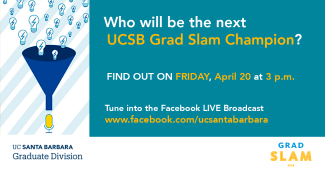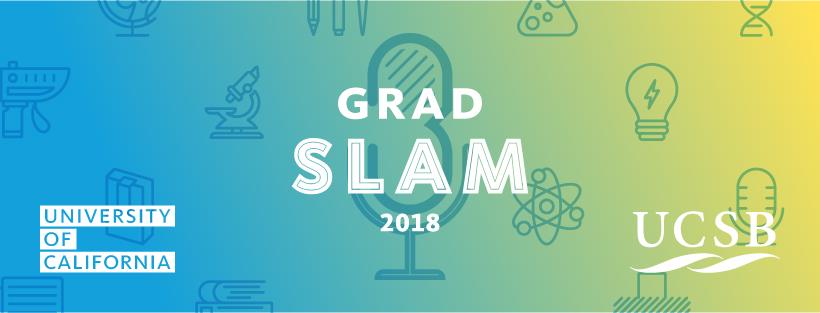Top Stories
After two weeks of competition, only 9 graduate students remain to compete in the final round of the 2018 Grad Slam this Friday. With thousands of dollars of prize money up for grabs, this is sure to be an event that you won't want to miss. If you can't make it in person, you can tune into the live-stream through UC Santa Barbara's Facebook page to catch all the excitement!


After two weeks of competition, only 9 graduate students remain âto compete in the final round of the 2018 Grad Slam this Friday. With thousands of dollars of prize money up for grabs, thisâ is sure to be an event that you won't want to miss. But don't worry, if you can't make it in person to support your friends and fellow grads, you can tune into the live-stream through UC Santa Barbara's Facebook page to catch all the excitement!
Final Round
Friday, April 20 | 3 to 4 p.m.
Corwin Pavilion
Katie Harrison | Communication
Communicating Resilience During Acute and Chronic Stress
The theory of resilience and relational load was tested with 60 couples and their adolescent children (ages 11-18) with type I diabetes (T1D). The couples participated in a stress inducing conversation task in their home, followed by random assignment to a two week intervention designed to increase their relationship maintenance. Before the intervention, stronger communal perceptions predicted greater maintenance for husbands and wives, but maintenance only reduced T1D stress for wives. The wives' and adolescents' T1D stress were also correlated, but the husbands' T1D stress was not significantly associated with either of them. Better maintenance was associated with less conflict during couples' conversations. Maintenance was also directly associated with less perceived and physiological stress (cortisol) from the conversation. Finally, wives in the intervention reported the most thriving, communal perspectives, and the least loneliness. The intervention also reduced adolescents' general life stress, but did not influence their T1D stress or thriving.
Erin Winslow | ââEnvironmental Science & Management
Coral Community Dynamics: A Mystery in Moorea, French Polynesia
Coral reefs around the world are experiencing mass bleaching events in response to global climate change and human impacts. Reef communities in Moorea, French Polynesia have not experienced dramatic bleaching, but the composition of coral taxa varies greatly around the island as reefs recover from disturbance. Why is this?
May ElSherif | Computer Science
#NotOkay: Understanding Gender-based Violence in Social Media
Gender-based violence (GBV) is a global epidemic that is powered, in part, by a culture of silence and denial of the seriousness of its repercussions. In this talk, we present one of the first investigations of GBV in social media. Considering Twitter as an open pervasive platform that provides means for open discourse and community engagement, we study user engagement with GBV related posts, and age and gender dynamics of users who post GBV content. We also study the specific language nuances of GBV-related posts. We find evidence for increased engagement with GBV-related tweets in comparison to other non-GBV tweets. Our hashtag-based topical analysis shows that users engage online in commentary and discussion about political, social movement-based, and common-place GBV incidents. Finally, with the rise of public figures encouraging women to speak up, we observe a unique blended experience of non-anonymous self-reported assault stories and an online community of support around victims of GBV. We discuss the role of social media and online anti-GBV campaigns in enabling an open conversation about GBV topics and how these conversations provide a lens into a socially complex and vulnerable issue like GBV. Last year's presentation was about street harassment in the physical world. This year, I will be talking about women discussing their stories in the digital world.
Rebecca Baker | English
Cognitive Cyborgs: Minds, Machines, and (Re)Mediated Techno-Cultural Identities in the Post-Millennium
The Millennial generation, born into a period of human history experiencing unprecedented levels of technological and social change, is easy to malign. Though the popular view holds that this generation has "lost" certain capacities for being and knowing, this easy invective circumvents other salient questions, such as what it might mean for humans to be "born digital", and how scholarship and reading practices can evolve to reflect increasingly rhizomatic, non-binary views of reality, identity, and socio-political possibility. Beginning with Donna Haraway's foundational "Cyborg Manifesto" from 1985 and drawing on current trends in Cognitive Literary Studies, this talk will discuss and attempt to situate the figure of the Cyborg as a techno-biological trickster with that of the Millennial-a subjectivity that exists in the liminal space of both paradox and potentiality.
Mengya Tao | Environmental Science & Management
A Safer World with Fewer Regrettable Chemicals
Being amazingly innovative as we are, we have created over 100 million chemical substances with around 84,000 being used on the market. However, only 1% of them are tested for their potential human health and ecological risk due to high cost in time, money and effort. To close the huge gap, we developed a rapid screening-level tool to estimate chemical's adverse impacts on human health and the environment.
Neil Dolinski | Materials
3D Printing with Color: One Solution, Multiple Materials
Additive manufacturing, or 3D printing, has enabled the production of structures useful throughout industry and cutting edge research. However, standard 3D printing approaches utilize harmful UV light, require slow layer-by-layer processing, and have vastly inferior properties relative to traditionally manufactured parts. Our group has developed a new technique for 3D printing, Solution Mask Liquid Lithography, which uses purely visible light to build parts 100x faster than state-of-the-art printers while completely eliminating layering. By varying the color of the light used in curing, we can produce parts with programmable local mechanical properties, allowing for the unprecedented growth of complex parts in a single step.
Andrea Figueroa-Caballero | âCommunication
Trial by TV: The Effects of News Coverage Linking Undocumented Immigrants with Criminality
An examination of the effects of crime news coverage featuring undocumented immigrants, specifically looking at punitive consequences.
Veronica Laos | âChemistry
Understanding Neurodegenerative Disorders: One Protein at a Time
As we approach our future, expecting growth in developing countries and a rise of an older population, we can anticipate an imminent rise in neurodegenerative disorders worldwide. It is crucial that we develop a fundamental understanding of the pathogenic cascade involved in the proliferation of these types of diseases. My work focuses on characterizing disease related proteins to identify neurotoxic targets, which can then be applied to evaluate therapeutic agents in their efficacy for treating neurodegenerative disorders.
Lauren Menzer | âEnvironmental Science & Management
âPoison in Your Panties
The chemicals used in the apparel industry range from pesticides and formaldehyde, to synthetic dyes and flame retardants. Many of these chemicals are known carcinogens, endocrine disruptors, and skin irritants that can have immediate or latent negative effects on human health and the environment. Scientific research is has identified these endocrine active compounds as adversely affecting human hormonal systems, but many gaps still exist in knowing the connections between how toxins interact with one another and within the human body. Our research pieces together the various pathways that mothers and newborns are exposed to endocrine disrupting chemicals from the apparel industry, and the extent to which these toxins impact their immediate and long-term health systems.